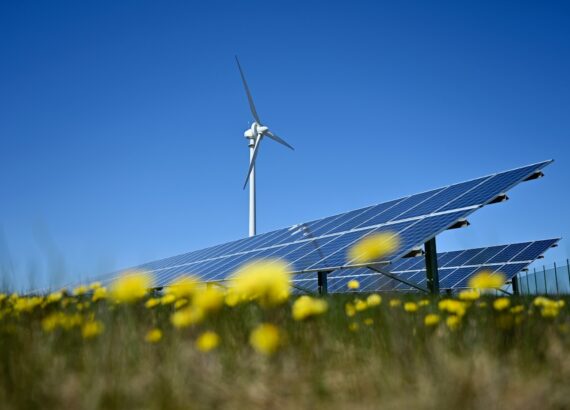How Geothermal Energy Can Help Save the Planet and Lower Your Bills

How Geothermal Energy Can Help Save the Planet and Lower Your Bills
Geothermal energy is a powerful and sustainable source of energy that has the potential to revolutionize our approach to power generation while mitigating the impact of climate change. Unlike fossil fuels, geothermal energy taps into the natural heat stored beneath the Earth’s surface, providing a reliable and renewable source of power. In addition to its environmental benefits, geothermal energy offers economic advantages, reducing energy costs and creating job opportunities.
This article explores the various ways in which geothermal energy can help save the planet and lower your bills, highlighting its environmental benefits, economic advantages, and potential for sustainable development.
1. Introduction to Geothermal Energy
1.1 What is Geothermal Energy?
It taps into the natural heat produced by the Earth’s core, which is a whopping 5,500 degrees Celsius (9,932 degrees Fahrenheit). This heat is then used to produce electricity or as a direct heat source for heating and cooling.
1.2 A Brief History of Geothermal Energy
The use of geothermal energy dates back thousands of years, with ancient civilizations recognizing its power and harnessing it for various purposes. In recent history, the first geothermal power plant was built in Italy in 1904, marking a significant milestone in geothermal energy utilization. Since then, the technology and understanding of geothermal energy have advanced, making it an increasingly viable and sustainable option for powering our modern world.
2. Understanding the Environmental Benefits of Geothermal Energy
2.1 Reduced Carbon Emissions and Air Pollution
One of the primary environmental benefits of geothermal energy is its minimal carbon emissions. Unlike fossil fuels, geothermal power plants do not burn any fuel to generate electricity, resulting in significantly lower greenhouse gas emissions. This reduction in carbon emissions helps combat climate change and improves air quality, making geothermal energy a cleaner and greener alternative.
2.2 Water Conservation and Protection
Geothermal energy production requires minimal water when compared to other forms of power generation. Unlike traditional power plants that rely heavily on water for cooling, geothermal power plants use a closed-loop system that recycles the same water repeatedly. This significantly reduces water consumption and alleviates the stress on local water supplies, promoting conservation and protecting precious freshwater sources.
2.3 Geothermal Energy and Land Use
Geothermal power plants have a relatively small land footprint, making them suitable for both urban and rural areas. Unlike large solar or wind farms, geothermal power plants can be built in a compact area without occupying vast stretches of land. This efficient use of space allows for the preservation of natural habitats and agricultural land, minimizing the impact on the environment.
3. Exploring the Economic Advantages of Geothermal Energy
3.1 Cost-Effectiveness and Long-Term Savings
While the initial setup costs of geothermal energy systems may be higher than traditional heating or cooling systems, they offer significant long-term savings. Geothermal heat pumps, for example, can reduce energy bills by up to 70%. Additionally, geothermal systems require less maintenance and have a longer lifespan, providing homeowners and businesses with substantial financial benefits over time.
3.2 Job Creation and Economic Growth
The geothermal industry has the potential to create numerous job opportunities and contribute to economic growth. Building, operating, and maintaining geothermal power plants requires a skilled workforce, stimulating job creation in various sectors. Additionally, geothermal projects often involve collaboration with local communities, providing economic benefits through increased tourism and business opportunities.
3.3 Geothermal Energy and Energy Independence
Geothermal energy offers a path toward increased energy independence. This enhances energy security, reduces vulnerability to global fuel price fluctuations, and promotes a more sustainable and self-reliant energy system.
4. Harnessing Geothermal Energy for Residential and Industrial Use
4.1 Geothermal Heat Pumps for Residential Heating and Cooling
Geothermal heat pumps are an excellent option for residential heating and cooling. These systems utilize the Earth’s constant temperature to efficiently transfer heat into or out of a building, providing comfortable indoor conditions year-round. Geothermal heat pumps are highly energy-efficient, reduce carbon emissions, and can save homeowners a significant amount of money on their energy bills.
4.2 Geothermal Power Generation for Industrial Applications
Geothermal power generation plays a vital role in supplying sustainable electricity to industrial applications. Industries that require a consistent and reliable power source, such as manufacturing and mining, can benefit from the stable and uninterrupted electricity geothermal plants provide. Moreover, industrial processes that require heat, such as food production or chemical manufacturing, can directly utilize geothermal energy, further reducing their environmental impact.
4.3 Geothermal District Heating Systems
Geothermal district heating systems provide a centralized solution for heating multiple buildings within a community or district. These systems use geothermal heat to generate hot water or steam, distributed through a network of pipes to heat residential, commercial, and public buildings. Geothermal district heating systems are highly efficient, and cost-effective, and offer a sustainable alternative to individual heating systems in densely populated areas.
In conclusion, geothermal energy offers a multitude of environmental and economic benefits. Its sustainable nature, reduced carbon emissions, lower water consumption, and economic advantages make it a valuable solution in the fight against climate change. While embracing geothermal energy may not solve all our energy challenges, it is undoubtedly a step in the right direction toward a cleaner and more sustainable future. So, let’s tap into the Earth’s natural heat and save the planet while lowering our bills!
5. Geothermal Energy’s Role in Reducing Carbon Emissions
5.1 Geothermal Energy as a Renewable and Clean Energy Source
When it comes to finding sustainable solutions to combat climate change, geothermal energy is a superstar. Unlike fossil fuels that emit greenhouse gases, geothermal energy is renewable and clean. It taps into the Earth’s natural heat, providing a constant, reliable source of power without harming the environment. By harnessing this natural heat, we can significantly reduce our carbon footprint and move towards a greener future.
5.2 Geothermal Energy’s Contribution to Climate Change Mitigation
Climate change is a pressing global issue, and geothermal energy plays a significant role in mitigating its impact. By generating electricity without burning fossil fuels, geothermal power plants produce minimal greenhouse gas emissions. This reduction in carbon emissions is crucial for curbing global warming and minimizing the adverse effects of climate change. Geothermal energy presents a viable and effective solution to combatting climate change while meeting our energy needs.

6. The Potential of Geothermal Energy in Sustainable Development
6.1 Geothermal Energy’s Integration into Sustainable Infrastructure Development
Sustainable development requires us to build infrastructure that minimizes its environmental impact. Geothermal energy presents a unique opportunity to integrate sustainability into our infrastructure. By using geothermal heat pumps for heating and cooling systems in buildings, we can achieve energy efficiency and reduce reliance on conventional energy sources. This integration not only lowers carbon emissions but also contributes to long-term sustainability.
6.2 Geothermal Energy and Sustainable Agriculture
Agriculture is a vital sector for sustainable development, and geothermal energy has a role to play here too. Geothermal resources can be used for greenhouse heating, soil warming, and even powering agricultural processes. The steady and reliable nature of geothermal energy makes it an attractive option for sustainable agriculture, providing favorable conditions for crop growth while reducing the carbon footprint associated with traditional agricultural practices.
6.3 Geothermal Energy’s Impact on Sustainable Transportation
Transportation is a significant contributor to carbon emissions, but geothermal energy can help drive sustainable transportation. Geothermal power can be used to charge electric vehicles, reducing our dependence on fossil fuels for transportation. The availability of geothermal power stations can create a network of charging stations, making electric vehicles more practical and accessible. By embracing geothermal energy, we can move towards a cleaner and greener transportation system.
7. Overcoming Challenges and Expanding Geothermal Energy Adoption
7.1 Technological Innovations and Research Advancements
To fully harness the potential of geothermal energy, we need continuous technological innovations and research advancements. This includes developing more efficient geothermal power plants, improving drilling techniques, and exploring enhanced geothermal systems. Investing in research and development will drive down costs and make geothermal energy more accessible and widely adopted.
7.2 Policy and Regulatory Support for Geothermal Energy
To accelerate the adoption of geothermal energy, governments and policymakers need to provide adequate support. This includes implementing favorable policies, such as tax incentives and subsidies, to encourage investment in geothermal projects. Additionally, regulatory frameworks should prioritize and streamline the permitting process for geothermal exploration and development, making it easier for companies to invest in this renewable energy source.
7.3 Public Awareness and Education on Geothermal Energy
Public awareness and education play a crucial role in expanding the adoption of geothermal energy. Many people are unaware of the potential and benefits of geothermal energy. By raising awareness through educational campaigns and public outreach initiatives, we can promote the advantages of geothermal energy and encourage individuals, communities, and businesses to embrace this sustainable power source.
8. Embracing Geothermal Energy for a Greener Future
Geothermal energy offers a viable and sustainable solution to our energy needs while reducing carbon emissions. Its integration into sustainable infrastructure, agriculture, and transportation can contribute to a greener future. Overcoming challenges through technological advancements, policy support, and public awareness will pave the way for the widespread adoption of geothermal energy. By embracing geothermal energy, we can make significant progress toward saving the planet, lowering our bills, and building a more sustainable world for future generations.
9. Conclusion
As the world continues to grapple with the challenges of climate change and rising energy costs, geothermal energy emerges as a viable solution that holds immense potential. By harnessing the Earth’s natural heat, geothermal energy offers us a sustainable and clean alternative to traditional energy sources. Its environmental benefits, such as reduced carbon emissions and water conservation, make it an invaluable tool in the fight against climate change.
Additionally, the economic advantages and job creation opportunities associated with geothermal energy make it a win-win solution for individuals, businesses, and communities. By embracing geothermal energy, we can pave the way for a greener future, one in which our planet is protected, and our energy bills are lowered.
FAQ
1. Is geothermal energy accessible everywhere?
Geothermal energy is more readily accessible in certain regions with abundant geothermal resources, such as areas near tectonic plate boundaries. However, advancements in technology have made it possible to harness geothermal energy in various locations, including those without naturally occurring hot springs or geysers.
3. Can I use geothermal energy for my home’s heating and cooling needs?
Absolutely! Geothermal heat pumps (GHPs) are an excellent residential heating and cooling option. GHPs utilize the stable temperature of the ground to efficiently heat or cool a home, reducing energy consumption and lowering utility bills. With proper installation and maintenance, geothermal heat pumps can provide long-term cost savings and environmental benefits.
4. How can geothermal energy contribute to sustainable development?
Geothermal energy can play a crucial role in sustainable development by providing clean and affordable power for various sectors. It can support sustainable infrastructure development, including powering eco-friendly buildings and transportation systems. Geothermal energy can also promote sustainable agriculture by providing heat for greenhouses and supporting geothermal aquaculture systems.
Thank you for reading 🙂












